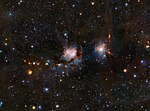Messier 78
| Messier 78 | |
|---|---|
 | |
| Bild av Messier 78 fångad med vidvinkelkameran på MPG /ESO 2,2-meters teleskop vid La Silla Observatory. | |
| Observationsdata | |
| Stjärnbild | Orion |
| Rektascension | 05t 46m 46,7s[1] |
| Deklination | 00° 00′ 50″[1] |
| Klass | Reflektionsnebulosa |
| Avstånd | 1 350 (415 pc) [2] ljusår lj |
| Skenbar storlek | 8 x 6 bågminuter' |
| Skenbar magnitud | 8,3[1] |
| Fysiska egenskaper | |
| Radie | 5 ljusår |
| Upptäckt | |
| Upptäcktsår | före 1780[3] |
| Upptäckare | Pierre Méchain |
| Andra beteckningar | |
| M78, NGC 2068, Ced55u, DG 80, IRAS 05442-0000[4] | |
| Se också: Öppna stjärnhopar, Lista över öppna stjärnhopar | |
Messier 78 (M78) även känd som NGC 2068, är en reflektionsnebulosa i stjärnbilden Orion. Den upptäcktes av Pierre Méchain 1780 och lades samma år in av Charles Messier i hans katalog över kometliknande objekt.[3]
Messier 78 är belägen ca 1 350 ljusår från jorden och är lätt att hitta även med små teleskop, som en suddig fläck med två stjärnor av tionde magnituden. Det är dessa stjärnor, HD 38563 A och HD 38563 B, som står för det ljus som reflekteras i nebulosan och därigenom gör den synlig.[5]
Egenskaper
M78-molnet innehåller en hop av stjärnor som är synliga i infrarött ljus.[2] Tack vare gravitationen har den molekylära gasen i nebulosan fragmenterats in i en hierarki av klumpar[2] de tyngre kärnor av vilka kan bildas stjärnor med massa upp till 5 solmassor.[6] Omkring 45 variabla stjärnor av typen T Tauri,[7] unga stjärnor som fortfarande håller på att bildas. På samma sätt är 17 Herbig-Haro-objekt kända i M78.[8]
Galleri
- VISTA bild av Messier 78.
- Spitzer bild av Messier 78.
Referenser
- Den här artikeln är helt eller delvis baserad på material från engelskspråkiga Wikipedia, 19 april 2021.
Noter
- ^ [a b c] Messier 78 (u-strasbg.fr). Hämtad 2016-02-14
- ^ [a b c] Walker-Smith, S. L.; Richer, J. S.; Buckle, J. V.; Smith, R. J.; Greaves, J. S.; Bonnell, I. A. (March 2013), ”The structure and kinematics of dense gas in NGC 2068”, Monthly Notices of the Royal Astronomical Society 429 (4): 3252–3265, doi:, Bibcode: 2013MNRAS.429.3252W.
- ^ [a b] Frommert, Hartmut; Kronberg, Christine (9 October 2018), ”Messier 78”, SEDS Messier pages (Students for the Exploration and Development of Space (SEDS)), http://messier.seds.org/m/m078.html, läst 5 december 2018.
- ^ ”Basic data: M 78 -- Reflection Nebula”. Centre de Données astronomiques de Strasbourg. http://simbad.u-strasbg.fr/simbad/sim-basic?Ident=Messier+78&submit=SIMBAD+search. Läst 1 september 2014.
- ^ Strom, S. E.; Grasdalen, G. L.; Strom, K. M. (July 1974), ”Infrared and optical observations of Herbig-Haro objects.”, Astrophysical Journal 191: 111–142, doi:, Bibcode: 1974ApJ...191..111S.
- ^ Motte, F.; André, P.; Ward-Thompson, D.; Bontemps, S. (June 2001), ”A SCUBA survey of the NGC 2068/2071 protoclusters”, Astronomy and Astrophysics 372 (3): L41–L44, doi:, Bibcode: 2001A&A...372L..41M.
- ^ Herbig, G. H.; Kuhi, L. V. (February 1963), ”Emission-Line Stars in the Region of NGC 2068”, Astrophysical Journal 137: 398, doi:, Bibcode: 1963ApJ...137..398H.
- ^ Zhao, Bing; Wang, Min; Yang, Ji; Wang, Hongchi; Deng, Licai; Yan, Jun; Chen, Jiansheng (September 1999), ”Newly Discovered Herbig-Haro Objects in the NGC 2068 and NGC 2071 Regions”, The Astronomical Journal 118 (3): 1347–1353, doi:, Bibcode: 1999AJ....118.1347Z.
Externa länkar
 Wikimedia Commons har media som rör Messier 78.
Wikimedia Commons har media som rör Messier 78.- [http:// web.archive.org/web/20060112185742/http://www.seds.org/messier/m/m078.html SEDS informerar om Messier 78]
- SEDS: Starforming Nebula M78
- NightSkyInfo.com – M78
- M78 Wide Field 2009 November 26
- M78 and Reflecting Dust Clouds in Orion 2010 March 2
- Haran, Brady; Haese, Paul. ”M78 – Reflection Nebula”. Deep Sky Videos. Nottingham Astronomy Group, University of Nottingham. http://www.deepskyvideos.com/videos/messier/M78_reflection_nebula.html.
| ||||||||
Media som används på denna webbplats
Författare/Upphovsman: ESO/Igor Chekalin, Licens: CC BY 4.0
This new image of the reflection nebula Messier 78 was captured using the Wide Field Imager camera on the MPG/ESO 2.2-metre telescope at the La Silla Observatory, Chile. This colour picture was created from many monochrome exposures taken through blue, yellow/green and red filters, supplemented by exposures through a filter that isolates light from glowing hydrogen gas. The total exposure times were 9, 9, 17.5 and 15.5 minutes per filter, respectively.
Looking like a pair of eyeglasses only a rock star would wear, this nebula brings into focus a murky region of star formation.
Best known as Messier 78, the two round greenish nebulae are actually cavities carved out of the surrounding dark dust clouds. The extended dust is mostly dark, even to Spitzer's view, but the edges show up in mid-wavelength infrared light as glowing red frames surrounding the bright interiors.
The light from young, newborn stars are starting to carve out cavities within the dust, and eventually, this will become a larger nebula.
A string of baby stars that have yet to burn their way through their natal shells can be seen as red pinpoints on the outside of the nebula. Eventually these will blossom into their own glowing balls, turning this two-eyed eyeglass into a many-eyed monster of a nebula.Författare/Upphovsman: ESO, Licens: CC BY 4.0
This richly detailed view of the star formation region Messier 78, in the constellation of Orion (The Hunter), was taken with the VISTA infrared survey telescope at ESO’s Paranal Observatory in Chile. As well as the blue regions of reflected light from the hot young stars the image also shows streams of dark dust and the red jets emerging from stars in the process of formation.





